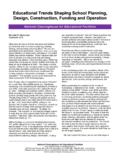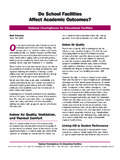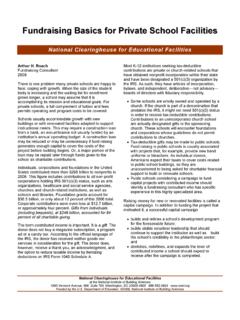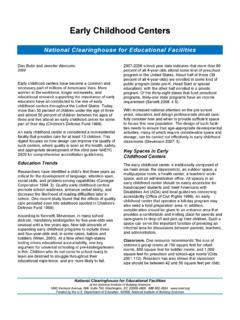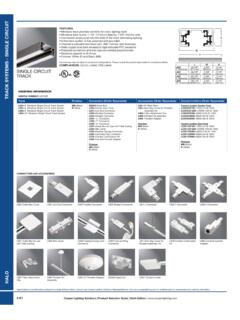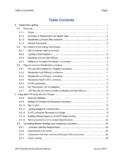Transcription of Lighting for Schools
1 Lighting for SchoolsNational Clearinghouse for Educational FacilitiesNational Clearinghouse for Educational Facilities1090 Vermont Avenue, , Suite 700, Washington, 20005 4905 888 552 0624 2001, National Institute of Building SciencesJames R. Benya, PEBenya Lighting DesignDecember 2001 Lighting is and always has been an important factorin designing and operating Schools . Until the1950s, natural light predominated as a means ofilluminating most school spaces. Classroom design wasbased in large part on time-honored relationshipsbetween window sizes and room dimensions. As electricpower costs declined and designers began to takeadvantage of the increased flexibility provided by electriclighting, daylighting took a secondary role.
2 Now, highlyenergy efficient windows and skylights and a renewedrecognition of the positive psychological and physiologi-cal effects of daylighting (Heschong Mahone Group)allow a healthy and economical mix of natural and elec-tric illumination in new and renovated DaylightingSimply adding windows or skylights to a classroom is notnecessarily responsible daylighting. Poorly designed day- Lighting , as with poorly designed electric Lighting , cancreate visual discomfort and disabling glare. Incorrectlyplaced daylighting can introduce undesirable solar heatgain, causing discomfort and increasing ventilation andair conditioning loads and energy daylighting design requires understanding a build-ing s local climate and use patterns and the location,placement, and shading of windows and skylights rela-tive to their solar orientation.
3 A good daylighting systemprovides: balanced, diffuse, glare-free daylight from two ormore directions; sufficient light levels for the tasks in the space; operable shading devices to reduce light intensityfor audio-visual programs and computer work; windows for interest, relaxation, and communica-tion with the outdoors; and, exterior shading devices as needed to minimizesolar heat gains during the cooling concept of cool daylightingis a systematic approachto daylighting design that ensures that the daylight iscontrolled through a combination of glazing systems(such as low-e), shading systems, and architecturaldesign.
4 The result is a building that uses significantly lessenergy than an ordinary school by simultaneously reduc-ing electric Lighting and cooling loads. However, to beeffective, daylighting must be supplemented by automati-cally controlled electric Lighting that dims in response todaylight is a side benefit to daylighting: by turning off theelectric lights when they are not needed, the life of theelectric Lighting system is extended and maintenancecosts are reduced. A simple automatic photo-controlsystem can switch off one, two, or three fluorescentlamps per light fixture, depending upon the amount ofdaylight present.
5 By reducing the use of the electriclights by 50 percent, their life span will be doubled andassociated maintenance costs cut in can be effective and energy efficient foralmost all school spaces, including classrooms, cafete-rias, offices, shops, gyms, pools, corridors, locker rooms,and study halls. Some daylighting approaches, especiallytop Lighting (skylights), can be added to existing build-ings. For instance, many gyms could easily employ simple, reliable commercial skylights that would allowlights to be turned off during much or all of the day. Thissaves energy and reduces the cost of maintaining theelectric Lighting system, a significant expense.
6 Although daylighting design for classrooms can be assimple as installing good windows, the best designsoften employ clerestories and other more complex light-ing devices such as light shelves. Remember, windowsthat provide a view can also introduce glare. Windowsalso introduce side light, which usually is not as good astop light for illuminating tasks. In summary, daylighting is beneficial to student learningin addition to simply being pleasant. Employed correctly,daylighting can dramatically cut electric Lighting , energy,and maintenance costs, even in cloudy or northern lati-tudes. The resultant energy savings can, in the longterm, offset the increased costs of adding daylightingwhile increasing comfort and student for Schools2 National Clearinghouse for Educational Facilities1090 Vermont Avenue, , Suite 700, Washington, 20005 4905 888 552 0624 2001, National Institute of Building SciencesElectric Lighting ChoicesEven if the school is well daylighted, an electric lightingsystem is needed for inclement days, early and late winter hours, and evening classes.
7 The challenge is toprovide a Lighting system that is energy efficient, has along life, and requires minimal the greatest energy efficiencyand best color rendering, school Lighting should employeither fluorescent T-8 or T-5 linear lamp technology withelectronic ballasts. The latest T-8 lamps, called secondgeneration,produce more than 10 percent more lightper watt than the original T-8 lamps and 50 percentmore light per watt than the old T-12 lamps (still themost commonly used lamps in older Schools ). The sec-ond-generation T-8 lamps are currently about 30 percentmore expensive than ordinary T-8 lamps, but their supe-rior color and light output are worth the cost and theylast about 20 percent longer.
8 In a typical classroom, theadded cost of purchasing second-generation lamps (ascompared to T-8 generic lamps) is about $5 per , if the additional light from the lamps is utilizedthrough good design practice, the classroom will useabout 200 fewer watts and will save about $50 per yearin energy costs. T-8 lamps can be easily retrofitted intoexisting Lighting linear Lighting systems are best suited to newschools or Schools undergoing major remodeling. Theyare most effective when used for suspended uplighting,direct-indirect pendant Lighting , cove Lighting , under-cabinet Lighting , or in specialized applications.
9 Becausethe T-5 lamp and ballast system is more expensive thanthe T-8 system, the two systems should be compared todetermine which best meets a school s needs. The T-5HO (high output) Lighting system is rapidly gaining promi-nence as the preferred Lighting system for gymnasiums,pools, and other spaces with high fluorescent lamps should replace incandescentlamps in downlights, wall bracket lights, and utility of improvements in low temperature perform-ance, compact fluorescent lamps also may be used forsome exterior Lighting applications such as canopy down-lights, utility wallpacks and some types of security intensity discharge (HID) lamps should be used primarily outdoors (in parking lots, athletic fields, andhigh-wattage exterior lights)
10 And for a few interior appli-cations. Metal halide lamps are strongly recommended(as opposed to high-pressure sodium) for their goodcolor rendering and white light, which provides betternight vision. Until recently, HID lamps were used ingyms, pools, and other spaces with high ceilings. Withthe advent of T-5 HO and multiple compact fluorescentlamps, however, indoor applications for HID lampsshould be chosen carefully and only after weighing a fluorescent alternative. The reason is simple: fluorescentsystems generate more light per watt and provide superior color. The exception is high color-renderingceramic metal halide lamps.

